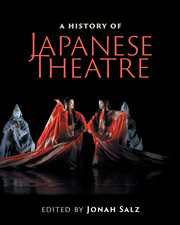Book contents
- Frontmatter
- Contents
- List of figures
- List of tables
- Contributors
- Contributors’ biographies
- Foreword
- Acknowledgments
- Note on Japanese terms
- List of abbreviations
- Timeline
- Editor's introduction
- I Traditional theatres
- Preface to Part I Japanese civilization arises
- 1 Ancient and early medieval performing arts
- Interlude Katari narrative traditions: from storytelling to theatre
- 2 Noh and Muromachi culture
- Interlude Noh and kyogen costumes and masks
- 3 Kyogen: classical comedy
- Interlude Iemoto : the family head system
- 4 Kabuki: superheroes and femmes fatales
- Interlude Nihonbuyo: classical dance
- Interlude Okinawan theatre: boundary of Japanese theatre
- 5 Bunraku: puppet theatre
- Interlude Misemono and rakugo : sideshows and storytelling
- Interlude Kamigata geinō : Kyoto-Osaka style
- Interlude Traditional theatre tomorrow: interview with Takemoto Mikio
- II Modern theatres
- Preface to Part II
- III Arcs and patterns
- IV Theatre architecture
- Preface to Part IV Evolution of Japanese theatre architecture
- V Theatre criticism
- VI Intercultural influences
- Epilogue: Frozen words and mythology
- Further reading
- Index
- References
2 - Noh and Muromachi culture
from Preface to Part I Japanese civilization arises
Published online by Cambridge University Press: 05 July 2016
- Frontmatter
- Contents
- List of figures
- List of tables
- Contributors
- Contributors’ biographies
- Foreword
- Acknowledgments
- Note on Japanese terms
- List of abbreviations
- Timeline
- Editor's introduction
- I Traditional theatres
- Preface to Part I Japanese civilization arises
- 1 Ancient and early medieval performing arts
- Interlude Katari narrative traditions: from storytelling to theatre
- 2 Noh and Muromachi culture
- Interlude Noh and kyogen costumes and masks
- 3 Kyogen: classical comedy
- Interlude Iemoto : the family head system
- 4 Kabuki: superheroes and femmes fatales
- Interlude Nihonbuyo: classical dance
- Interlude Okinawan theatre: boundary of Japanese theatre
- 5 Bunraku: puppet theatre
- Interlude Misemono and rakugo : sideshows and storytelling
- Interlude Kamigata geinō : Kyoto-Osaka style
- Interlude Traditional theatre tomorrow: interview with Takemoto Mikio
- II Modern theatres
- Preface to Part II
- III Arcs and patterns
- IV Theatre architecture
- Preface to Part IV Evolution of Japanese theatre architecture
- V Theatre criticism
- VI Intercultural influences
- Epilogue: Frozen words and mythology
- Further reading
- Index
- References
Summary
Noh is masked, lyric dance-drama which developed alongside kyogen comedy in the mid-fourteenth century. Scripts of great poetic force tell of the spirits of unrequited lovers, fallen warriors, mothers who have lost children to slave traders, and hunters paying for their sin of killing sentient beings. One “dances” (舞う, mau) the central role of a noh play, unlike other theatrical genres, where one “acts” (演じる, enjiru). An elegant costume, wig, and painted fan are often the only properties, framing a delicately carved mask – an indispensable tool that controls all aspects of performance. As musical dance-theatre, noh has been compared to Greek theatre and to opera. It is considered the world's oldest continuous theatre tradition, with scripts, theoretical writings, masks, and family lines dating back six centuries. In 2001, noh, including kyogen, was designated by UNESCO in its first ever Proclamation of Masterpieces of the Oral and Intangible Heritage of Humanity.
ELEMENTS OF PERFORMANCE
Noh (能, sometimes transcribed as nō, “skills or artistry”) is a musical dance theatre that is fundamentally non-realistic. One or two masked characters act while the chorus sings (utai, 謡) poetic verses of five–seven syllabic meter, with instrumental musical accompaniment (hayashi, 囃子). Noh performance is usually translated as theatre, because of its dramatic plots. However, Zeami Motokiyo (1363?–1443?), who perfected the art of noh in the fourteenth century, wrote that noh performers needed to master nikyoku-santai: the two basic arts of dancing and singing of the three roles of old man, woman, and warrior.
Restrictive forms and space
Noh's smallest units of movement are called kata (型, forms), beginning with the most basic: posture (kamae) and walk (hakobi). Kata range from simple movements such as standing and sitting to purely abstract ones, such as circling or zig-zag floor patterns, to stylized movements with clear meanings such as shiori, bringing the cupped hand to eye-level, symbolizing crying. With various kata as building blocks, a sequence of movements is created. This limited number of kata is strictly choreographed; their size, speed, angle, or power is determined according to the character portrayed. Selection from multiple permissible kata allows some flexibility of interpretation. The appeal of kata lies in this paradox of restraint bringing forth infinite possibility.
- Type
- Chapter
- Information
- A History of Japanese Theatre , pp. 24 - 61Publisher: Cambridge University PressPrint publication year: 2016
References
- 1
- Cited by



